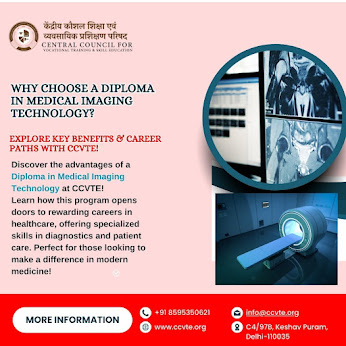Introduction
Medical imaging technology is a vital field in healthcare, offering essential diagnostic support through techniques like X-rays, MRI, CT scans, and ultrasounds. As demand for medical imaging professionals grows, choosing the right educational pathway is crucial. A diploma in medical imaging technology from a reputable institution like the Central Council for Vocational Training and Skill Education (CCVTE) offers excellent training and career opportunities. This article covers the essential steps to a career in medical imaging technology, along with insights into why CCVTE stands out.
Step 1: Understand the Role of a Medical Imaging Technologist
Medical imaging technologists are skilled professionals responsible for operating imaging equipment, performing diagnostic imaging exams, and supporting physicians in patient diagnosis. Key responsibilities include:
- Operating equipment like MRI machines, CT scanners, and X-ray machines.
- Preparing patients for imaging procedures.
- Ensuring quality images are produced for accurate diagnosis.
- Maintaining equipment and ensuring compliance with safety standards.
Step 2: Obtain a Relevant Education in Medical Imaging
One of the quickest and most effective ways to enter this field is through a diploma in medical imaging technology. This program provides the hands-on training and theoretical knowledge needed for entry-level positions in medical imaging. CCVTE’s diploma program offers the following advantages:
- Comprehensive curriculum covering the basics of medical imaging.
- Practical training to gain real-world experience.
- Access to modern equipment and technologies.
Step 3: Choose the Right Institution - Why CCVTE?
Choosing the right educational institution is critical, and CCVTE (Central Council for Vocational Training and Skill Education) has become a preferred choice for many students pursuing a diploma in medical imaging technology. Here’s why CCVTE is an excellent option:
- Government-Recognized: CCVTE’s courses meet national standards and are recognized by relevant government bodies.
- Industry-Relevant Curriculum: Designed by industry experts, CCVTE’s diploma programs ensure you acquire skills in line with industry requirements.
- Career-Oriented Training: CCVTE emphasizes practical, hands-on training, making graduates well-prepared for the job market.
Benefit of CCVTE: Choosing CCVTE for your diploma means you’re not only receiving quality education but also accessing career support and placement services that enhance job prospects.
Step 4: Enroll in a Diploma Program in Medical Imaging Technology
The diploma program at CCVTE typically covers:
- Fundamentals of medical imaging: X-ray, MRI, CT, and ultrasound basics.
- Radiographic techniques and safety protocols: Practical knowledge to ensure patient safety.
- Pathology and physiology basics: Essential knowledge to support diagnostic procedures.
- Clinical practice: Real-life practice to develop confidence and competence.
Step 5: Complete Clinical Training and Internships
Most diploma programs, including those at CCVTE, offer hands-on clinical training. During this phase, students work in healthcare settings under supervision to apply their knowledge and develop their technical skills.
Why Clinical Training is Crucial:
- Real-world application of knowledge and skills.
- Exposure to diverse cases that enhance learning.
- Networking opportunities with professionals in the field.
Step 6: Seek Certification and Licensing
Upon completing your diploma in medical imaging technology, you may need to obtain certification or licensure, depending on your location. Certification enhances job prospects and often is required by employers.
Step 7: Explore Career Opportunities
Graduates of CCVTE’s diploma in medical imaging technology have a variety of career options, including:
- Radiologic Technologist
- MRI Technician
- CT Scan Technologist
- Ultrasound Technician
- Nuclear Medicine Technologist
These roles are found in diverse settings such as hospitals, diagnostic imaging centers, and clinics, offering competitive salaries and career growth.
Conclusion
A career in medical imaging technology is a fulfilling option with great employment opportunities.By enrolling in a skill development programme at CCVTE, you gain industry-aligned skills, practical training, and career support. Whether your interest lies in X-rays, MRIs, CT scans, or ultrasound, CCVTE’s comprehensive approach prepares you for success in the field. Take the first step toward a promising career in healthcare by choosing CCVTE.
FAQ
Q1: What is the eligibility for a diploma in medical imaging technology?
A1: Generally, candidates must have completed high school with science subjects to enroll in a diploma program.
Q2: How long does the program take?
A2: A diploma in medical imaging technology usually takes around 1-2 years, depending on the program structure.
Q3: Does CCVTE offer placement support?
A3: Yes, CCVTE provides career support, including job placement assistance and industry connections.
Q4: What skills are required for success in medical imaging technology?
A4: Attention to detail, technical proficiency, communication skills, and a compassionate approach to patient care.

